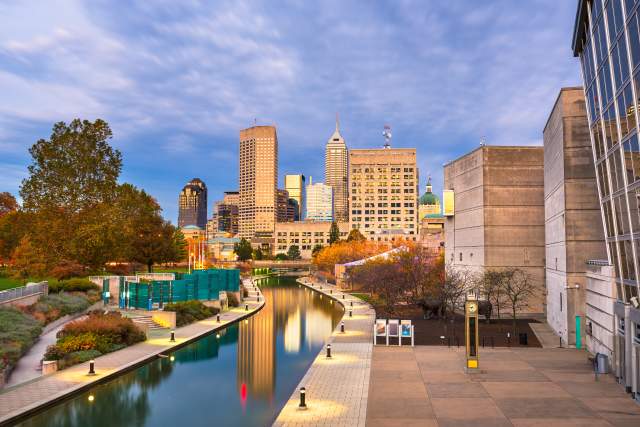“Give me six hours to chop down a tree,
and I will spend the first four sharpening the axe.”
– Abraham Lincoln
Traveling without a plan is a form of art for some, but travel planning is more of a science for those with mobility or accessibility challenges. It can mean the difference between an invigorating and enjoyable experience and one more stressful than a vacation should ever be. After all, cobblestone streets might be quaint, but they’re not wheelchair-friendly.
Visit Indy, the destination management organization (DMO) that serves as the official host of Indianapolis, Ind., understands the gift it gives by offering a comprehensive online Accessible Indy Guide to help make travel work for everyone. The guide includes information and accessibility tips for the most popular experiences, including parking, drop-off points, venue particulars and accommodations, whether reduced prices are offered, and transportation resources.
Beyond all this, a cornerstone of the effort are the accessibility stories written by locals with challenges.
“The core of any destination experience is the people you encounter while you’re there, so when we came to building this guide, it was natural that we would put locals front and center as part of the storytelling experience,” said Jeff Robinson, senior director of marketing at Visit Indy.
To ensure it has enough representation on the website so everyone can find someone in the city they can relate to, the DMO worked with its partner organizations to find people who represent a range of challenges, from needing wheelchair access to resources for visual impairment.
“We wanted to make sure they can see the destination through the lens of people who are here and dealing with challenges every day and getting the most out of their Indianapolis experience,” Robinson said.
Visit Indy's Accessibility Guide
For the last decade, “Indy Like a Local” has been a cornerstone of Visit Indy’s marketing strategy. It’s enlisted local thought leaders, cultural icons, and a diverse range of community members to share their insights on what to do, see, eat, and enjoy in Indianapolis. Including the same strategy for the accessibility guide was a natural extension.
Melody Cooper, who has cerebral palsy, loves working and exploring downtown, especially Monument Circle and especially at Christmastime. Brandon Scott navigates the city’s sporting venues in a wheelchair while cheering on amateur, regional, and national teams. David Geeslin, who made history in 2006 as the first deaf person to earn a doctorate from an Indiana university, loves outdoor experiences like the Indianapolis Zoo and White River Gardens. (Enjoy their and others’ recommendations here.)
“They all felt very honored to share their stories with our visitors,” Robinson said. “Our citizens are our ambassadors, and these people were no different. They have a lot of pride in the place they call home, and were very eager to share their personal experiences, particularly with the type of visitors who align with their own experiences. It did not take a lot of arm-twisting — the minute we asked them to contribute, they were excited to do so and were quick to get us the information we needed. I think they feel like their story wasn’t being told, so when we asked them to do that, they were flattered and excited to help others who need it.”
Highlighted accessibility stories featured on Visit Indy's website
Creating such a comprehensive accessibility guide was a significant undertaking, but Robinson said the months spent collecting data about the venues and determining resources to recommend was worth it.
“The last thing you want is for a visitor with challenges to not go to that sporting event or that museum or not make the most of their experience because they’re worried that they aren't going to be able to manage it,” he said. “We thought it was important to build a guide that clued them into accessible features with all of our major partners.”
A driving motivation behind the effort was the personal experience of Leonard Hoops, president and CEO of Visit Indy. His son has cerebral palsy, but that doesn’t stop the family from taking full advantage of all the sporting events and recreational opportunities the area offers.
By doing so much research, the DMO is trying to assure all potential visitors that they can have a great time in Indianapolis. They can pick what they want to do and go and know all they need about ramp access, audio tours, quiet spaces, and other special accommodations. Transportation needs are always at the top of the list for visitors with challenges, so the accessibility guide covers not only accessibility tips upon arriving at the Indianapolis International Airport but public transportation, adapted driving vehicles, and accessible van and scooter rentals.
“With every traveler, we want to take as many roadblocks out of their selection as possible because sometimes a small thing can change a travel decision,” said Robinson. “By working hard to get as many of the answers for them upfront without making them search on their own, we could hopefully ease that process of answering their questions and moving Indy to the front of their selection process.”
Robinson said the DMO learned just how accessible Indianapolis already was, a fact it is proud to share. And while not measured, Robinson said he believes this comprehensive information serves as a competitive advantage for meetings and events because it gives planners confidence knowing their attendees can meet their needs regardless of what they are.


